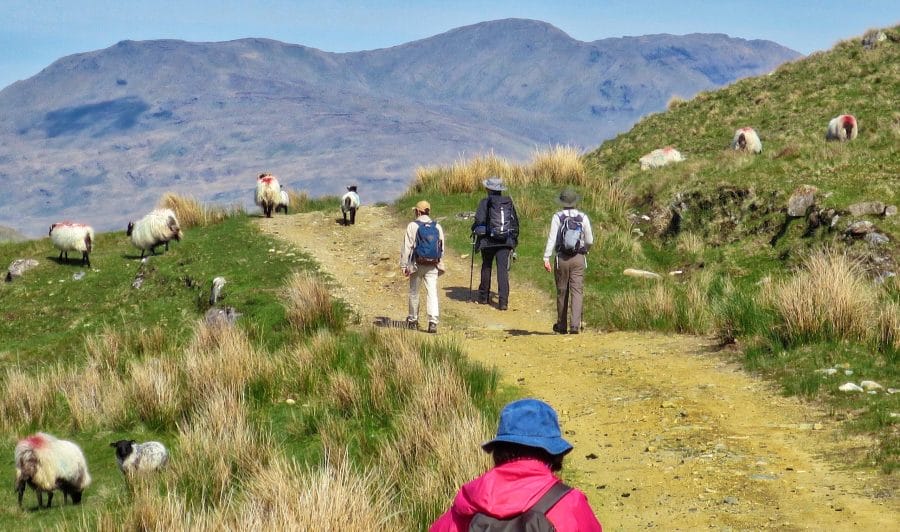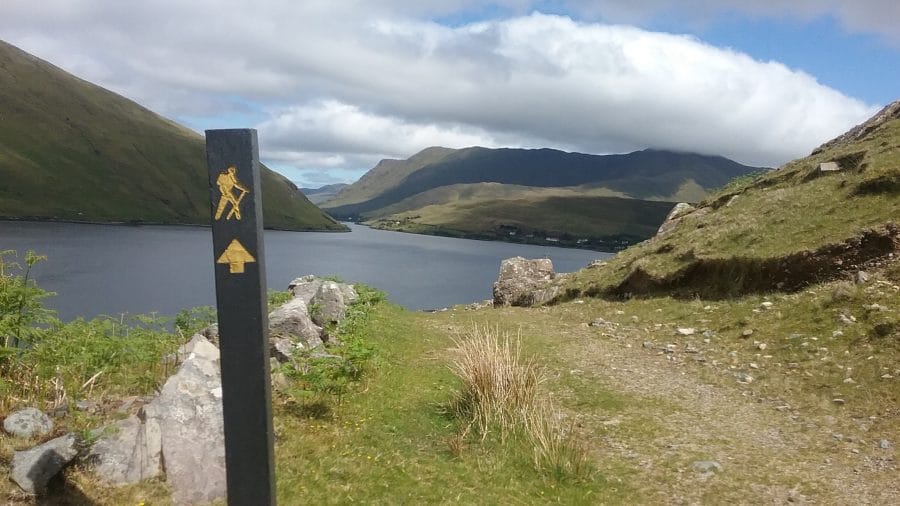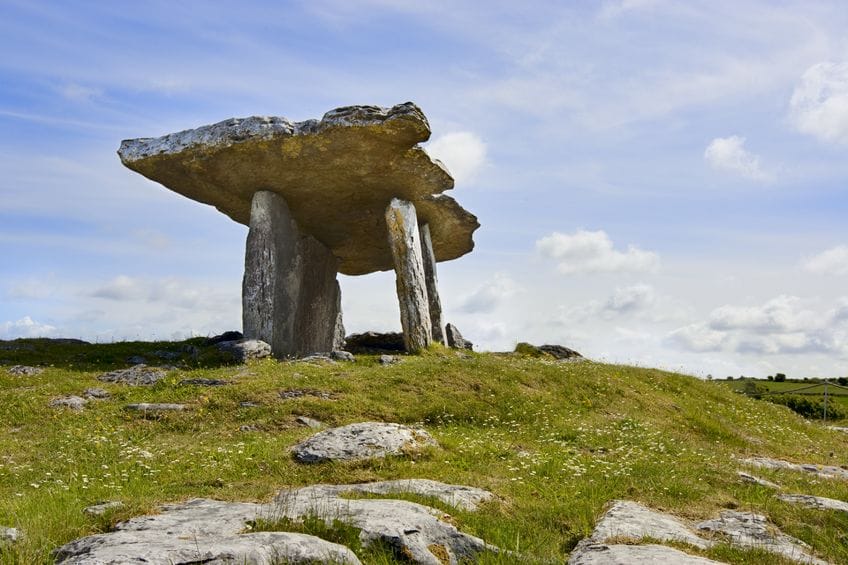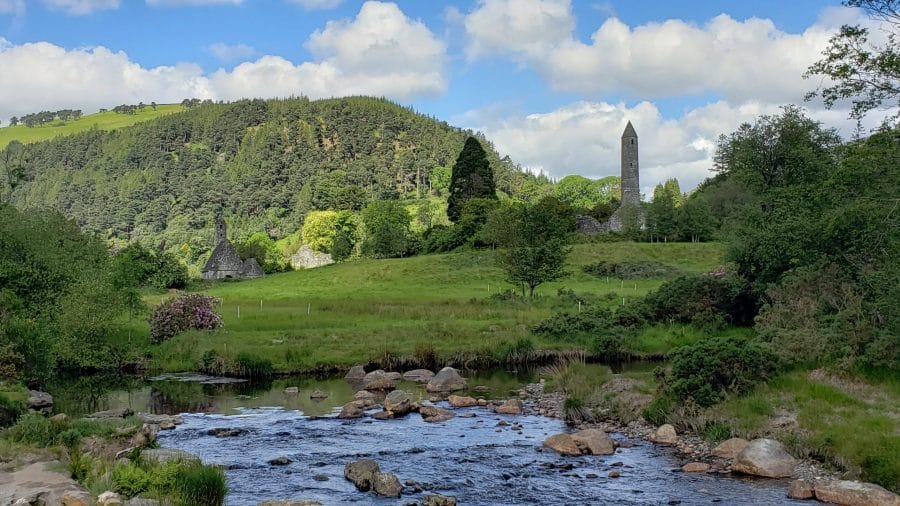There is certainly no shortage of great hiking regions in Ireland. Majestic mountain ranges, cozy pubs and historical monuments can be found in many places in Ireland. Anyone who spends their entire Ireland hiking holiday in a certain area has the chance to get to know the special characters of that region. In addition, you can immerse yourself in the nature, culture and history and get to know them from within.
When choosing between the west and east for the best hiking regions in Ireland, the key consideration is whether you would prefer the more varied trails of the west or the bigger hills and mountains of the east.

Hiking regions the West of Ireland
Connemara
Connemara is a dream for hikers who love remote areas and majestic mountain ranges. The barren, unwooded landscape allows a view of rugged rock formations and steep mountain slopes. Boggy valleys stretch between the most famous mountain ranges, the Maamturk Mountains and the 12 Bens. This wild hiking region is garnished by architectural gems such as Kylemore Abbey, the much-photographed Benedictine abbey at the foot of the mountains, which is reflected in the waters of Pollacapall Lough. St Patrick’s Church in Maumean or Mam Ean has braved the weather for centuries and is evidence of the first traces of Christianity in Ireland.

Hiking trails in Connemara
Ambitious hikers dare to climb the peaks of Connemara on unpaved paths with GPS and maps. Even families can climb the Diamond Hill Trail in the national park . And if you want to cross this unique landscape on long-distance hiking trails, you can walk on the Western Way from the fishing village of Oughterard, past the only fjord in Ireland to the holy mountain Croagh Patrick in Mayo.
Connemara can be reached from Galway, one of the largest cities on the west coast and famous for festivals related to art and culture. Connemara itself is one of the most famous Gaeltacht areas. Irish is the predominant language here. Warning: you will only find Irish place names on street signs in some areas.

The Burren – Unique geological formations
The limestone landscape of The Burren is a geological and archaeological sensation. The Gaelic name of The Burren means something like “the fertile rock”, which indicates the unique ecosystem in this area. A variety of flowers grow on the seemingly barren limestone terraces. Mediterranean plants, orchids and even arctic plants have adapted to the prevailing micro-climate.
The human settlement history of over 6,000 years has also left astonishing traces. The oldest human traces in Ireland were found in the Alice and Gwendoline’s cave: scratched ornaments on a bear’s kneecap. Stone monuments such as the Poulnabrone Dolmen grave are still puzzling to scientists today. They testify to a time when the west coast of Ireland was considered the end of the world and had its very own spiritual attraction.

Hiking the Burren Way
Get up close and personal with this incomparable landscape on the Burren Way. This 98-kilometer long-distance hiking trail also takes you to the world-famous Cliffs of Moher, the cliffs that plunge steeply into the sea for kilometers. For day trippers, a hike around Mullaghmore, in the Burren National Park, is worthwhile. Different marked routes take you to the heart of this mystical landscape made of silver stone.

Traditional music
The Burren is located in County Clare. County Clare is not only a beautiful walking area, the county is also known for the extraordinary musicality of its residents. And that means something in Ireland. In the summer, music festivals lasting several days, so-called fleadhs, take place in many villages. Traditional Irish music is often played in several pubs at the same time and entry is free. Places like Doolin, Tulla, Ennis and Feakle are all known for excellent fleadhs. After a long hike in the silence of nature, the tunes sound twice as good.

Hiking regions in the East of Ireland
The Wicklow Mountains and Glendalough
Even from Dublin you can see the Wicklow Mountains in the gaps between tall buildings. The deep forests and high mountain ranges were considered relatively inaccessible to British colonial rule. Despite the proximity to the metropolis, groups of rebels gathered here. The early Christians also valued the remoteness of the Wicklow Mountains, albeit for completely different reasons. In the Glendalough Valley you can still visit the ruins of St Kevin’s monastery from the 6th century. The round tower is a typical building from around a thousand years ago, when the monastery settlement flourished.

Hiking in Wicklow
Many city dwellers now use the Wicklow Mountains as a recreational area. The peace and strength of the mountains, which are older than the Himalayas, are a blessing for everyone who wants to escape the stress of everyday life. The Wicklow Way was Ireland’s first long-distance footpath and runs from Clonegal to Dublin, right past Glendalough. Other highlights on the 130km (81 mile) hiking trail include glimpses of stately homes and lush green spaces, such as the Powerscourt Estate, and the tallest waterfall in Ireland.
It is not for nothing that Wicklow is called the “Garden of Ireland”.
A classic day hike in the Wicklow Mountains is the ascent of the Sugarloaf (Sugar Loaf). The towering mountain is a landmark of the Wicklow Mountains and served pilgrims and travelers as a point of reference on the way to Glendalough. Two differently marked paths take you either up to the top, the Great Sugarloaf (4km), or in just about an hour to a high plateau (2.5km).
It is particularly beautiful in the Wicklow Mountains between June and September when the blooming heather turns the mountain slopes into a sea of purple and pink colors.

The Morne Mountains
The Morne Mountains are located in the north-east of the Irish island, but they are part of Great Britain. Located between Dublin and Belfast, this hiking region is also a popular travel destination for local and international visitors. Due to the increasing number of visitors, the infrastructure in the form of hiking trails and parking lots is excellent.
The Morne Mountains have been featured several times in pop culture. Musicians from John Lennon to Thin Lizzy have mentioned them in their lyrics. In the recent past they served as a filming location for the world famous series Game of Thrones. The highest mountain in these granite mountains is Slieve Donard at 850 meters.
Hiking in the Mournes
The Morne Mountains are connected by their own long distance hiking trail, the Morne Way. Although this is relatively short (only 42km or 26 miles), it is part of the more than a thousand kilometers long Ulster Way, a hiking trail that circles Northern Ireland and includes famous trails like the Causeway Coast Way.
Those who like to immerse themselves in the history of a region on their hikes can follow the historic quarry stone wall on the Morne Wall Challenge , which hundreds of workers built between 1904 and 1922. The wall is one of the defining features of the Morne Mountains and was built after Belfast’s water supply officers acquired land in the Mornes to ensured the city’s water supply.
At over 35km (22 miles), the Morne Wall hike is a sporty challenge and takes you to 7 of the 10 highest peaks in Northern Ireland.


